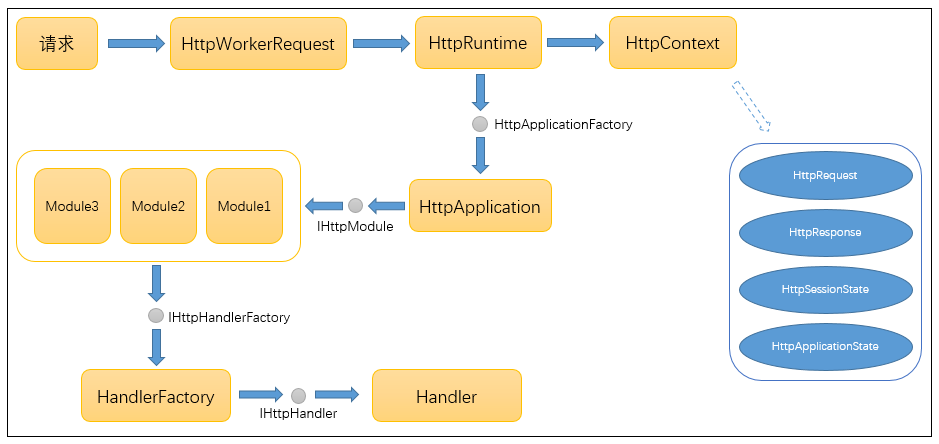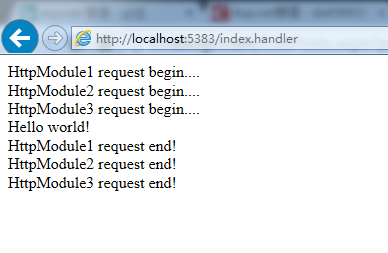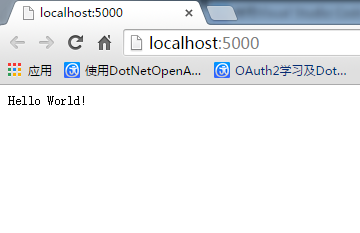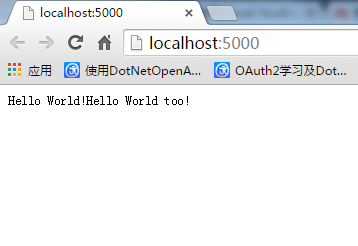使用Visual Studio Code开发Asp.Net Core WebApi学习笔记(四)-- Middleware
本文记录了Asp.Net管道模型和Asp.Net Core的Middleware模型的对比,并在上一篇的基础上增加Middleware功能支持。
在演示Middleware功能之前,先要了解一下Asp.Net管道模型发生了什么样的变化。
第一部分:管道模型
1. Asp.Net管道
在之前的Asp.Net里,主要的管道模型流程如下图所示:

请求进入Asp.Net工作进程后,由进程创建HttpWorkRequest对象,封装此次请求有关的所有信息,然后进入HttpRuntime类进行进一步处理。HttpRuntime通过请求信息创建HttpContext上下文对象,此对象将贯穿整个管道,直到响应结束。同时创建或从应用程序池里初始化一个HttpApplication对象,由此对象开始处理之前注册的多个HttpModule。之后调用HandlerFactory创建Handler处理程序,最终处理此次请求内容,生成响应返回。
下面用一个简单的Asp.Net程序来验证这个流程。
使用VS2015创建一个空的Asp.Net项目,根据向导添加HttpModule.cs、HttpHandler.cs、Global.asax文件
using System.Web; namespace WebApplicationTest
{
public class HttpModule1 : IHttpModule
{
public void Dispose()
{ } public void Init(HttpApplication context)
{
context.BeginRequest += (sender, e) =>
{
context.Response.Write("HttpModule1 request begin....<br />");
}; context.EndRequest += (sender, e) =>
{
context.Response.Write("HttpModule1 request end!<br />");
};
}
} public class HttpModule2 : IHttpModule
{
public void Dispose()
{ } public void Init(HttpApplication context)
{
context.BeginRequest += (sender, e) =>
{
context.Response.Write("HttpModule2 request begin....<br />");
}; context.EndRequest += (sender, e) =>
{
context.Response.Write("HttpModule2 request end!<br />");
};
}
} public class HttpModule3 : IHttpModule
{
public void Dispose()
{ } public void Init(HttpApplication context)
{
context.BeginRequest += (sender, e) =>
{
context.Response.Write("HttpModule3 request begin....<br />");
}; context.EndRequest += (sender, e) =>
{
context.Response.Write("HttpModule3 request end!<br />");
};
}
}
}
HttpModule.cs
using System.Web; namespace WebApplicationTest
{
public class HttpHandler : IHttpHandler
{
public bool IsReusable
{
get
{
return true;
}
} public void ProcessRequest(HttpContext context)
{
context.Response.ContentType = "text/html";
context.Response.Write("Hello world!<br />");
context.Response.End();
}
}
}
HttpHandler.cs
配置Web.Config。以下是在IIS7环境下的配置内容。
<?xml version="1.0" encoding="utf-8"?>
<!--
有关如何配置 ASP.NET 应用程序的详细信息,请访问
http://go.microsoft.com/fwlink/?LinkId=169433
-->
<configuration>
<system.web>
<compilation debug="true" targetFramework="4.5"/>
<httpRuntime targetFramework="4.5"/>
</system.web>
<system.webServer>
<validation validateIntegratedModeConfiguration="false"/>
<handlers>
<add name="handler" verb="GET" path="index.handler" type="WebApplicationTest.HttpHandler,WebApplicationTest"/>
</handlers>
<modules>
<add name="module1" type="WebApplicationTest.HttpModule1,WebApplicationTest"/>
<add name="module2" type="WebApplicationTest.HttpModule2,WebApplicationTest"/>
<add name="module3" type="WebApplicationTest.HttpModule3,WebApplicationTest"/>
</modules>
</system.webServer>
</configuration>
启动调试,访问地址 http://localhost:5383/index.handler ,可以看到页面内容。

之前版本的Asp.Net MVC正是通过 UrlRoutingModule.cs 类和 MvcHandler.cs 类进行扩展从而实现了MVC框架。
2、Asp.Net Core管道
而在Asp.Net Core里面,管道模型流程发生了很大的变化:

IHttpModule和IHttpHandler不复存在,取而代之的是一个个中间件(Middleware)。
Server将接收到的请求直接向后传递,依次经过每一个中间件进行处理,然后由最后一个中间件处理并生成响应内容后回传,再反向依次经过每个中间件,直到由Server发送出去。
中间件就像一层一层的“滤网”,过滤所有的请求和相应。这一设计非常适用于“请求-响应”这样的场景——消息从管道头流入最后反向流出。
接下来将演示在Asp.Net Core里如何实现中间件功能。
第二部分、Middleware
其实,在这个系列的第一篇里面,已经展示了管道的一个简单用法。这里再详细讲解一下如何实现自定义管道。
Middleware支持Run、Use和Map三种方法进行注册,下面将展示每一种方法的使用方式。
一、Run方法
所有需要实现的自定义管道都要在 Startup.cs 的 Configure 方法里添加注册。
public void Configure(IApplicationBuilder app, ILoggerFactory loggerFactory)
{
// 添加日志支持
loggerFactory.AddConsole();
loggerFactory.AddDebug(); // 添加NLog日志支持
loggerFactory.AddNLog(); // 添加自定义中间件
app.Run(async context =>
{
await context.Response.WriteAsync("Hello World!");
}); // 添加MVC中间件
//app.UseMvc();
}
启动调试,访问地址 http://localhost:5000/ ,页面显示Hello World!字样。

再次添加一个Run方法
public void Configure(IApplicationBuilder app, ILoggerFactory loggerFactory)
{
// 添加日志支持
loggerFactory.AddConsole();
loggerFactory.AddDebug(); // 添加NLog日志支持
loggerFactory.AddNLog(); // 添加自定义中间件
app.Run(async context =>
{
await context.Response.WriteAsync("Hello World!");
}); app.Run(async context =>
{
await context.Response.WriteAsync("Hello World too!");
}); // 添加MVC中间件
//app.UseMvc();
}
启动调试,再次访问发现页面上只有Hello World!字样。
原因是:Run的这种用法表示注册的此中间件为管道内的最后一个中间件,由它处理完请求后直接返回。
二、Use方法
public void Configure(IApplicationBuilder app, ILoggerFactory loggerFactory)
{
// 添加日志支持
loggerFactory.AddConsole();
loggerFactory.AddDebug(); // 添加NLog日志支持
loggerFactory.AddNLog(); // 添加自定义中间件
app.Use(async (context, next) =>
{
await context.Response.WriteAsync("Hello World!");
}); // 添加MVC中间件
//app.UseMvc();
}
启动调试,访问页面同样显示Hello World!字样。我们发现使用Use方法替代Run方法,一样可以实现同样的功能。
再次添加一个Use方法,将原来的Use方法内容稍作调整,尝试实现页面显示两个Hello World!字样。
public void Configure(IApplicationBuilder app, ILoggerFactory loggerFactory)
{
// 添加日志支持
loggerFactory.AddConsole();
loggerFactory.AddDebug(); // 添加NLog日志支持
loggerFactory.AddNLog(); // 添加自定义中间件
app.Use(async (context, next) =>
{
await context.Response.WriteAsync("Hello World!");
await next();
}); app.Use(async (context, next) =>
{
await context.Response.WriteAsync("Hello World too!");
}); // 添加MVC中间件
//app.UseMvc();
}
启动调试,访问页面

将两个Use方法换个顺序,稍微调整一下内容,再次启动调试,访问页面,发现字样输出顺序也发生了变化。
public void Configure(IApplicationBuilder app, ILoggerFactory loggerFactory)
{
// 添加日志支持
loggerFactory.AddConsole();
loggerFactory.AddDebug(); // 添加NLog日志支持
loggerFactory.AddNLog(); HelloworldMiddleware.cs // 添加自定义中间件
app.Use(async (context, next) =>
{
await context.Response.WriteAsync("Hello World too!");
await next();
}); app.Use(async (context, next) =>
{
await context.Response.WriteAsync("Hello World!");
}); // 添加MVC中间件
//app.UseMvc();
}
从上面的例子可以发现,通过Use方法注册的中间件,如果不调用next方法,效果等同于Run方法。当调用next方法后,此中间件处理完后将请求传递下去,由后续的中间件继续处理。
当注册中间件顺序不一样时,处理的顺序也不一样,这一点很重要,当注册的自定义中间件数量较多时,需要考虑哪些中间件先处理请求,哪些中间件后处理请求。
另外,我们可以将中间件单独写成独立的类,通过UseMiddleware方法同样可以完成注册。下面将通过独立的中间件类重写上面的演示功能。
新建两个中间件类: HelloworldMiddleware.cs 、 HelloworldTooMiddleware.cs
using System.Threading.Tasks;
using Microsoft.AspNetCore.Http; namespace WebApiFrame.Core.Middlewares
{
public class HelloworldMiddleware
{
private readonly RequestDelegate _next; public HelloworldMiddleware(RequestDelegate next){
_next = next;
} public async Task Invoke(HttpContext context){
await context.Response.WriteAsync("Hello World!");
await _next(context);
}
}
}
HelloworldMiddleware.cs
using System.Threading.Tasks;
using Microsoft.AspNetCore.Http; namespace WebApiFrame.Core.Middlewares
{
public class HelloworldTooMiddleware
{
private readonly RequestDelegate _next; public HelloworldTooMiddleware(RequestDelegate next){
_next = next;
} public async Task Invoke(HttpContext context){
await context.Response.WriteAsync("Hello World too!");
}
}
}
HelloworldTooMiddleware.cs
修改 Startup.cs 的Configure方法内容
public void Configure(IApplicationBuilder app, ILoggerFactory loggerFactory)
{
// 添加日志支持
loggerFactory.AddConsole();
loggerFactory.AddDebug(); // 添加NLog日志支持
loggerFactory.AddNLog(); // 添加自定义中间件
app.UseMiddleware<HelloworldMiddleware>();
app.UseMiddleware<HelloworldTooMiddleware>(); // 添加MVC中间件
//app.UseMvc();
}
启动调试,访问页面,可以看到同样的效果。
三、Map方法
Map方法主要通过请求路径和其他自定义条件过滤来指定注册的中间件,看起来更像一个路由。
修改 Startup.cs 的Configure方法内容,增加静态方法MapTest
public void Configure(IApplicationBuilder app, ILoggerFactory loggerFactory)
{
// 添加日志支持
loggerFactory.AddConsole();
loggerFactory.AddDebug(); // 添加NLog日志支持
loggerFactory.AddNLog(); // 添加自定义中间件
app.Map("/test", MapTest); // 添加MVC中间件
//app.UseMvc();
} private static void MapTest(IApplicationBuilder app){
app.Run(async context => {
await context.Response.WriteAsync("Url is " + context.Request.PathBase.ToString());
});
}
启动调试,访问路径 http://localhost:5000/test ,页面显示如下内容

但是访问其他路径时,页面没有内容显示。从这个可以看到,Map方法通过类似路由的机制,将特定的Url地址请求引导到固定的方法里,由特定的中间件处理。
另外,Map方法还可以实现多级Url“路由”,其实就是Map方法的嵌套使用
// 添加自定义中间件
app.Map("/level1", lv1App => {
app.Map("/level1.1", lv11App => {
// /level1/level1.1 }); app.Map("/level1.2", lv12App => {
// /level1/level1.2 });
});
也可以通过MapWhen方法使用自定义条件进行“路由”
public void Configure(IApplicationBuilder app, ILoggerFactory loggerFactory)
{
// 添加日志支持
loggerFactory.AddConsole();
loggerFactory.AddDebug(); // 添加NLog日志支持
loggerFactory.AddNLog(); // 添加自定义中间件
app.MapWhen(context =>
{
return context.Request.Query.ContainsKey("a");
}, MapTest); // 添加MVC中间件
//app.UseMvc();
} private static void MapTest(IApplicationBuilder app)
{
app.Run(async context =>
{
await context.Response.WriteAsync($"Url is {context.Request.Path.ToString()}{context.Request.QueryString.Value}");
}); }
启动调试,访问路径 http://localhost:5000/path?a=1&b=2 ,页面显示如下内容

只有当请求参数中含有a时,页面才正常显示内容。
四、其他内置的中间件
Asp.Net Core框架内置了几个中间件

最后,用自定义中间件实现一个简单的访问日志记录功能,记录每一次请求的内容和响应时间。
1. 添加日志模型 VisitLog.cs
using System;
using System.Collections.Generic;
using System.Linq; namespace WebApiFrame.Models
{
public class VisitLog
{
public string Url { get; set; } public IDictionary<string, string> Headers { get; set; } = new Dictionary<string, string>(); public string Method { get; set; } public string RequestBody { get; set; } public DateTime ExcuteStartTime { get; set; } public DateTime ExcuteEndTime { get; set; } public override string ToString()
{
string headers = "[" + string.Join(",", this.Headers.Select(i => "{" + $"\"{i.Key}\":\"{i.Value}\"" + "}")) + "]";
return $"Url: {this.Url},\r\nHeaders: {headers},\r\nMethod: {this.Method},\r\nRequestBody: {this.RequestBody},\r\nExcuteStartTime: {this.ExcuteStartTime.ToString("yyyy-MM-dd HH:mm:ss.fff")},\r\nExcuteStartTime: {this.ExcuteEndTime.ToString("yyyy-MM-dd HH:mm:ss.fff")}";
}
}
}
2. 添加访问日志记录中间件 VisitLogMiddleware.cs ,同时添加UseVisitLogger扩展方法。
using Microsoft.AspNetCore.Builder;
using Microsoft.AspNetCore.Http;
using Microsoft.Extensions.Logging;
using System;
using System.IO;
using System.Linq;
using System.Threading.Tasks;
using WebApiFrame.Models; namespace WebApiFrame.Core.Middlewares
{
public class VisitLogMiddleware
{
private readonly RequestDelegate _next; private readonly ILogger logger; private VisitLog visitLog; public VisitLogMiddleware(RequestDelegate next, ILoggerFactory loggerFactory)
{
_next = next;
logger = loggerFactory.CreateLogger<VisitLogMiddleware>();
} public async Task Invoke(HttpContext context)
{
visitLog = new VisitLog();
HttpRequest request = context.Request;
visitLog.Url = request.Path.ToString();
visitLog.Headers = request.Headers.ToDictionary(k => k.Key, v => string.Join(";", v.Value.ToList()));
visitLog.Method = request.Method;
visitLog.ExcuteStartTime = DateTime.Now; using (StreamReader reader = new StreamReader(request.Body))
{
visitLog.RequestBody = reader.ReadToEnd();
} context.Response.OnCompleted(ResponseCompletedCallback, context);
await _next(context);
} private Task ResponseCompletedCallback(object obj)
{
visitLog.ExcuteEndTime = DateTime.Now;
logger.LogInformation($"VisitLog: {visitLog.ToString()}");
return Task.FromResult();
}
} public static class VisitLogMiddlewareExtensions
{
public static IApplicationBuilder UseVisitLogger(this IApplicationBuilder builder)
{
return builder.UseMiddleware<VisitLogMiddleware>();
}
}
}
3. 在 Startup.cs 添加中间件支持
public void Configure(IApplicationBuilder app, ILoggerFactory loggerFactory)
{
// 添加日志支持
loggerFactory.AddConsole();
loggerFactory.AddDebug(); // 添加NLog日志支持
loggerFactory.AddNLog(); // 添加自定义中间件
app.UseVisitLogger(); app.Run(async context =>
{
await context.Response.WriteAsync("Hello World!");
}); // 添加MVC中间件
//app.UseMvc();
}
4. 启动调试,访问地址 http://localhost:5000/ ,查看调试控制台日志打印信息。

另外,如果你比较细心会发现,在Configure方法里有这样一句代码: app.UseMvc(); ,Asp.Net Core Mvc正是通过这个方法借用中间件来扩展实现了MVC框架。
使用Visual Studio Code开发Asp.Net Core WebApi学习笔记(四)-- Middleware的更多相关文章
- 使用Visual Studio Code开发Asp.Net Core WebApi学习笔记(一)-- 起步
本文记录了在Windows环境下安装Visual Studio Code开发工具..Net Core 1.0 SDK和开发一个简单的Web-Demo网站的全过程. 一.安装Visual Studio ...
- 使用Visual Studio Code开发Asp.Net Core WebApi学习笔记(八)-- 多环境开发
本篇将演示Asp.Net Core如何在多环境下进行开发适配. 在一个正规的开发流程里,软件开发部署将要经过三个阶段:开发.测试.上线,对应了三个环境:开发.测试.生产.在不同的环境里,需要编写不同的 ...
- 使用Visual Studio Code开发Asp.Net Core WebApi学习笔记(十)-- 发布(Windows)
本篇将在这个系列演示的例子上继续记录Asp.Net Core在Windows上发布的过程. Asp.Net Core在Windows上可以采用两种运行方式.一种是自托管运行,另一种是发布到IIS托管运 ...
- 使用Visual Studio Code开发Asp.Net Core WebApi学习笔记(九)-- 单元测试
本篇将结合这个系列的例子的基础上演示在Asp.Net Core里如何使用XUnit结合Moq进行单元测试,同时对整个项目进行集成测试. 第一部分.XUnit 修改 Project.json 文件内容, ...
- 使用Visual Studio Code开发Asp.Net Core WebApi学习笔记(三)-- Logger
本篇是在上一篇的基础上添加日志功能,并记录NLog在Asp.Net Core里的使用方法. 第一部分:默认Logger支持 一.project.json添加日志包引用,并在cmd窗口使用 dotnet ...
- [转]使用Visual Studio Code开发Asp.Net Core WebApi学习笔记(三)-- Logger
本文转自:https://www.cnblogs.com/niklai/p/5662094.html 本篇是在上一篇的基础上添加日志功能,并记录NLog在Asp.Net Core里的使用方法. 第一部 ...
- 使用Visual Studio Code开发Asp.Net Core WebApi学习笔记(七)-- 结构化配置
本篇将记录.Net Core里颇有特色的结构化配置的使用方法. 相比较之前通过Web.Config或者App.Config配置文件里使用xml节点定义配置内容的方式,.Net Core在配置系统上发生 ...
- 使用Visual Studio Code开发Asp.Net Core WebApi学习笔记(六)-- 依赖注入
本篇将介绍Asp.Net Core中一个非常重要的特性:依赖注入,并展示其简单用法. 第一部分.概念介绍 Dependency Injection:又称依赖注入,简称DI.在以前的开发方式中,层与层之 ...
- 使用Visual Studio Code开发Asp.Net Core WebApi学习笔记(五)-- Filter
在上一篇里,介绍了中间件的相关内容和使用方法.本篇将介绍Asp.Net Core MVC框架的过滤器的相关内容和使用方法,并简单说明一下与中间件的区别. 第一部分.MVC框架内置过滤器 下图展示了As ...
随机推荐
- iOS学习之UIActionSheet的使用
UIActionSheet是在iOS弹出的选择按钮项,可以添加多项,并为每项添加点击事件. 为了快速完成这例子,我们打开Xcode 4.3.2, 先建立一个single view applicatio ...
- .nil? .empty? .blank? .present? in Ruby on Rails
We get confused when there are many options to choose from. Same is the case when it comes to use an ...
- rubymine配置 rspec
If you go in Run > Edit Configurations... And select All Specs in <Your Project> you'll see ...
- Mybatis where 1=1 和 <where>标签
<select id="selSampleListByIDX4" resultMap="BaseResultMap" parameterType=&quo ...
- Java基础-面板组件
- Nginx 配置指令location 匹配符优先级和安全问题【转】
Nginx配置指令location匹配符优先级和安全问题 使用nginx 很久了,它的性能高,稳定性表现也很好,得到了很多人的认可.特别是它的配置,有点像写程序一样,每行命令结尾一个";&q ...
- 【cl】sikuli启动不了
公司电脑:win7+64位 问题:点击sikuli_ide没有反应 卸载了,启动电脑,重新安装.
- javascript自执行匿名函数
1)自执行匿名函数: 常见格式:(function() { /* code */ })(); 2)作用: function中的code代码在解释时就已经在运行了.因此可以用它创建命名空间, ...
- 求链表中倒数第k个节点
注意鲁棒性和算法效率的典型例题:(头文件省略) typedef struct node { int data; struct node* next; }ListNode; ListNode* Find ...
- POJ 3308 Paratroopers(最小割EK(邻接表&矩阵))
Description It is year 2500 A.D. and there is a terrible war between the forces of the Earth and the ...
